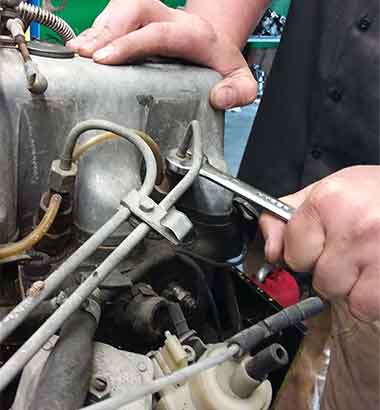W123 300D DIY Collision Repair
or, How I Spent My Quarantine
by Nick Medlin, edited by Sheila Heaney
The Crash
I woke up
on February 26th at 6:00 sharp like I normally do. I got ready and went outside
to warm up my 1984 Mercedes 300D. It was about 50 degrees and unusually foggy. I’ve
seen worse, so I didn’t think about it much and went on with my morning routine and then got in my W123 and began my drive to school. It was
about a 40 minute drive that changed from open country roads to stuffy city
traffic many times on the same trip. I had my amber fog lights turned on but it was
so thick I could barely see 30 feet ahead. I was rounding a turn when suddenly
the city traffic was right in front of me. It was at a place that usually had
little no congestion so I did not drive as defensively as I normally do.
The person in front of me and I both slammed on our brakes but without ABS I
couldn’t stop in time. In a tragic moment that would replay for some time to come, I hit the SUV. It
sat so high that my extra-large Mercedes bumper didn't even touch his vehicle at all. All of the impact to my
beloved W123 was taken by the grille, hood, headlights, core support,
side panels, and almost everything that touched them. Most of the damage was to the driver's side. If you look in
the background you can see how thick the fog is and this is about an hour and a
half after it happened meaning it had cleared up a lot.
Moving Forward: Buy a Parts Car!
After I got it towed and went to school I immediately got
online to find a parts car. I found a 1983 W123 300D in pretty worn out shape
for cheap and not too far away from me. Fortunately the parts I needed were
mostly rust free and in very good condition. It was a light grey in contrast to
my dark grey but other than that I considered myself very fortunate. I got the
car and less than a day later I was working on the repairs.
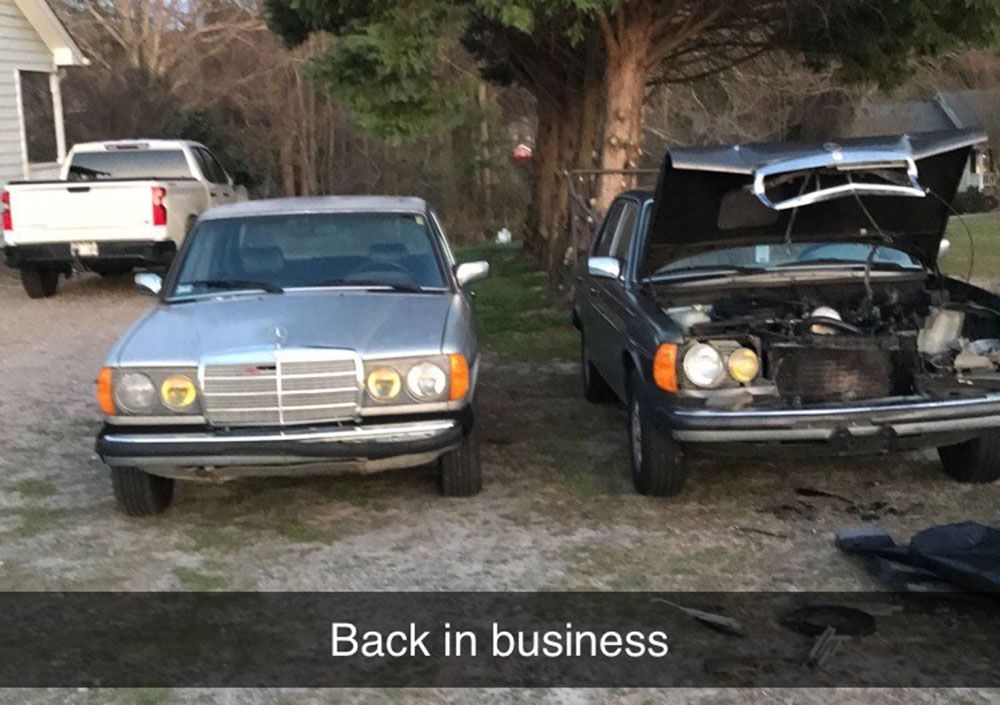
Tearing Apart my W123
The first thing I needed to do was get everything out of the
way in my 300D. Things like the core support, radiator, condenser, headlights,
fender panels, and hood needed to be removed. As I was taking everything apart
I made a startling discovery that my OM617 engine was not where it used to be.
The crash had broken the support arm on one side and ripped the engine mount on
the other side into three pieces. The engine was pushed back about two to three
inches. I did a quick inspection of the block and made sure there were no
cracks or holes in the block and was glad to not see any. I decided to finish
clearing everything before I messed with the engine so I could get around
easier.
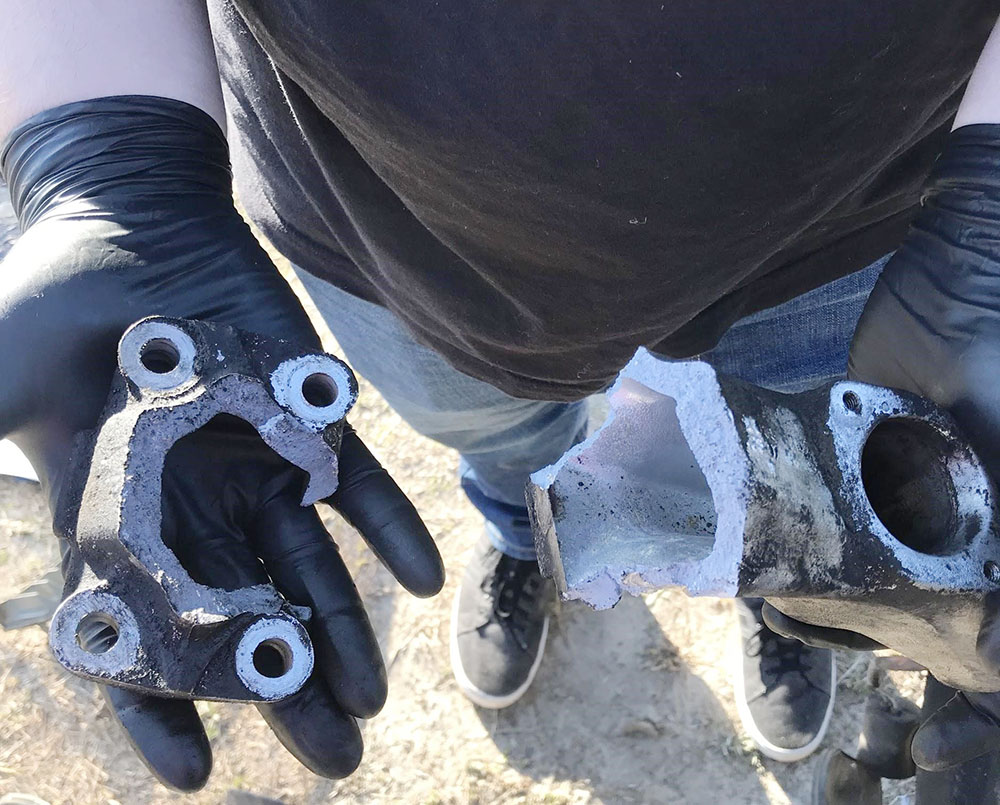
The next large task was to remove the core support. I bought a spot weld remover that can be attached to a drill and got to work. The good thing is that the welds are pretty much symmetrical on both sides, so once you get one side done it's pretty easy to get the other side done quickly. When I got all of the twisted metal out of the way I focused on moving the engine.
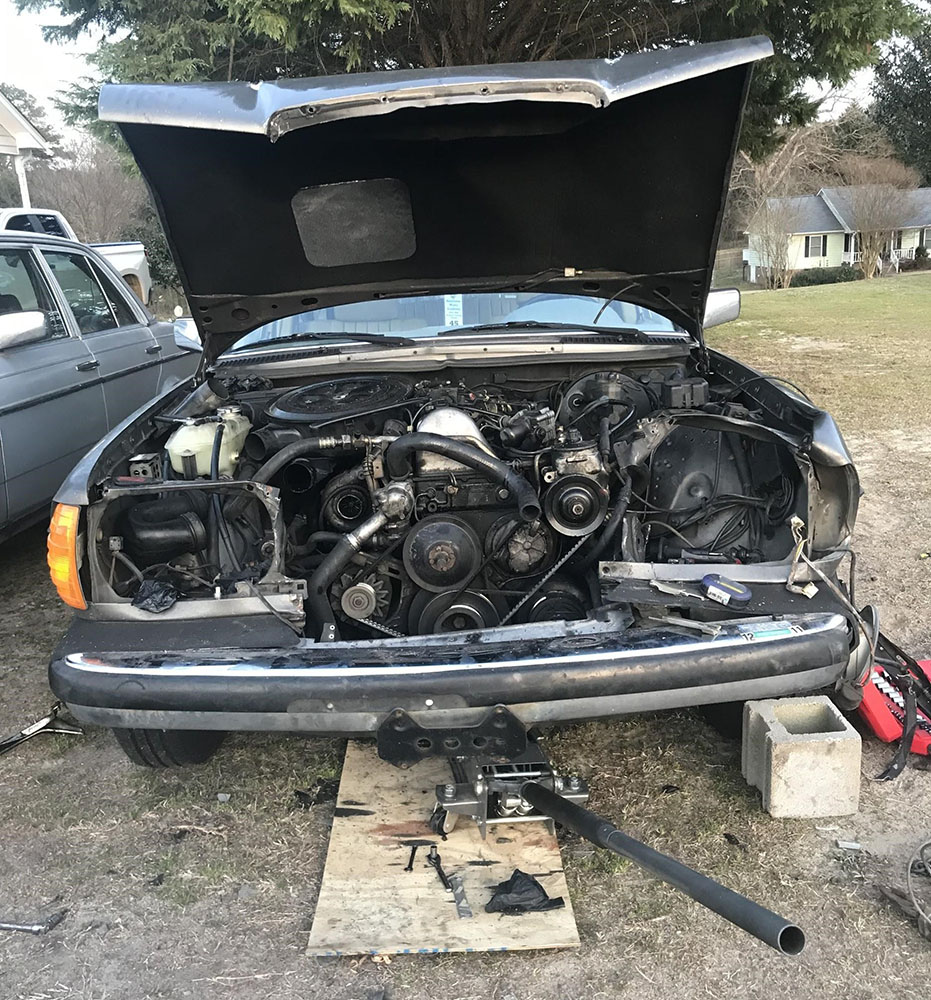
I disconnected all of the mounts for the engine and transmission. I realized
the crash was worse than I initially thought when I saw the bolts bent pretty
sharply. The cross member and transmission mount were bent like crazy. Luckily
the donor car had brand new engine and transmission mounts so I swapped
everything into my 300D. Once everything was in place, I hooked a winch up to
the engine and slowly pulled it in place to where it was supposed to be.
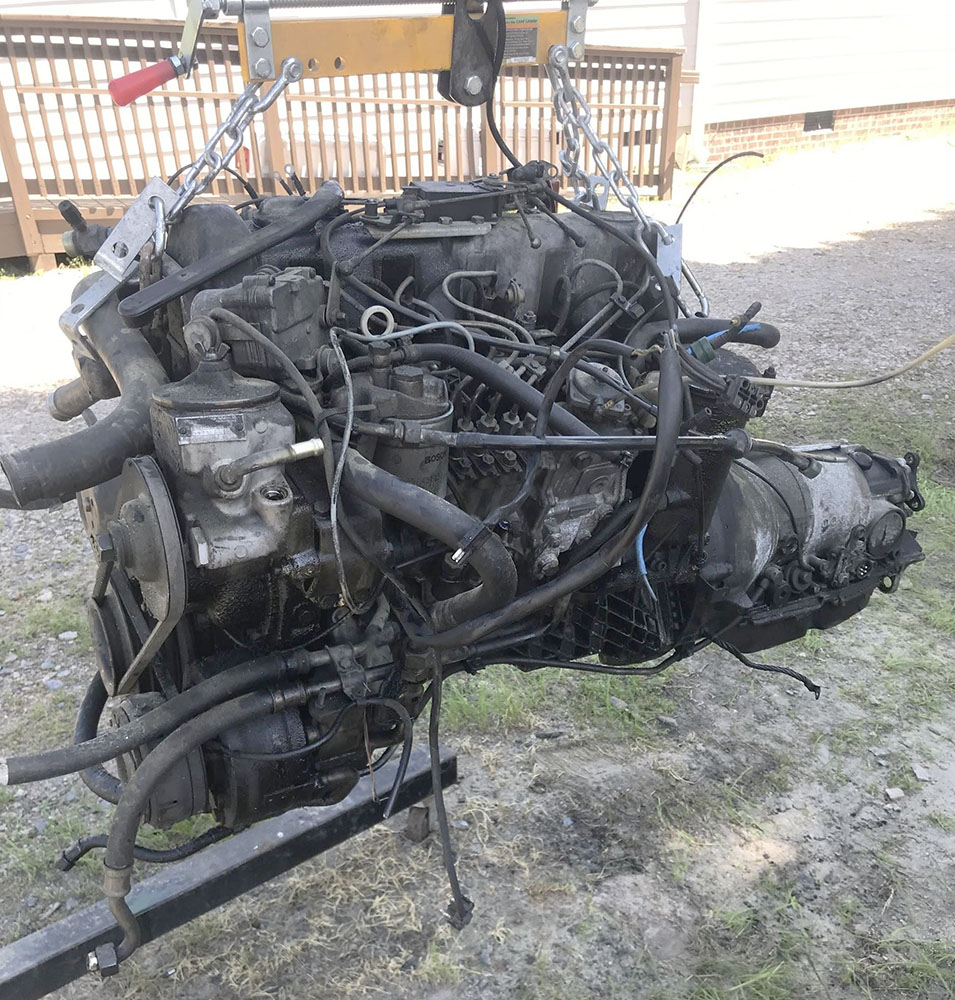

When everything was bolted up I moved onto dismantling the parts car. I started with the front, things like the radiator, condenser, and headlights needed to be removed before I could cut the core support off. Once they were out, the spot weld cutter made it easy to do clean and precise cuts. This helped me when I reattached the core support because I knew exactly where the welds were. After that was out, I decided it would be better to take everything out of the engine bay of the parts car that I could, and then I could move on to reassembling my W123.
Putting the 300D Back Together Again
To reinstall the core support, I considered attaching it with nuts and bolts but decided it would be better to weld it back in. I didn't have a welder so I hired a shop to weld it back in. They did a job that was good enough but not superb. Interestingly many shops in my area were terrified of working on an old Mercedes-Benz. Almost all of them wouldn't weld the core support back in for me. The ones that wanted to would have charged me almost double the standard rate. The shop I chose didn't charge me an arm and a leg so I guess I got what I paid for.
Once the support was back in, I put the condenser and
radiator back in. It was at this moment that I realized my A/C system had never
been converted to R134 and still ran on R12. Luckily the parts car had been
converted so many of the parts I was swapping were ready to go. I knew if I put
R134 in right now my compressor would die so I decided I could live without AC
for a few months and put that project on the backburner.
I hooked all the lines up to the radiator and finished putting all of the panels and lights back in. Finally, the car was starting to look like it did before. I decided to go ahead and do a complete fluid change since most of them were low or empty. After spending a small fortune on motor oil, coolant and transmission fluid, I got to work. It was the first time I had replaced the transmission filter, let alone dropped the transmission pan. I was pleased to not see any metal and a young-looking aftermarket filter showing it had been changed in the not-too-distant past. I have never been so careful of dust and dirt before in my life. Once the filter and pan were bolted back up I relaxed and moved on to motor oil and coolant. When they were filled correctly I eagerly waited to start my car.
The time had come, three months of hard work leading up to this moment. Thousands of questions flooded my mind, “What if it runs badly?”, “What if there's a hole or crack in the block I didn't see?”, “What if it doesn't even start?”. I decided there was only one way to find out, and turned the key. Instantly she started right up, didn't even turn over 5 times! No ticks, no stuttering, no crazy, or missing noises. What a relief!
The engine itself sounded good but I could hear grinding
coming from the front area. From a quick inspection, I discovered the water
pump's central shaft had been pushed back making the pulley wheel rub against
the crankshaft pulley wheel. I pulled the pump out and put in a used one that I
had laying around. Now that that was finished I had to get her up to
temperature. After 20 minutes of idling and constantly checking fluid levels, I
discovered a small leak coming from the top of the radiator. I loosened the top
hose clamps and the hose just fell off. I had over-tightened the hose clamps on
the old, brittle plastic making it break apart. I got some JB weld and put it
back together.
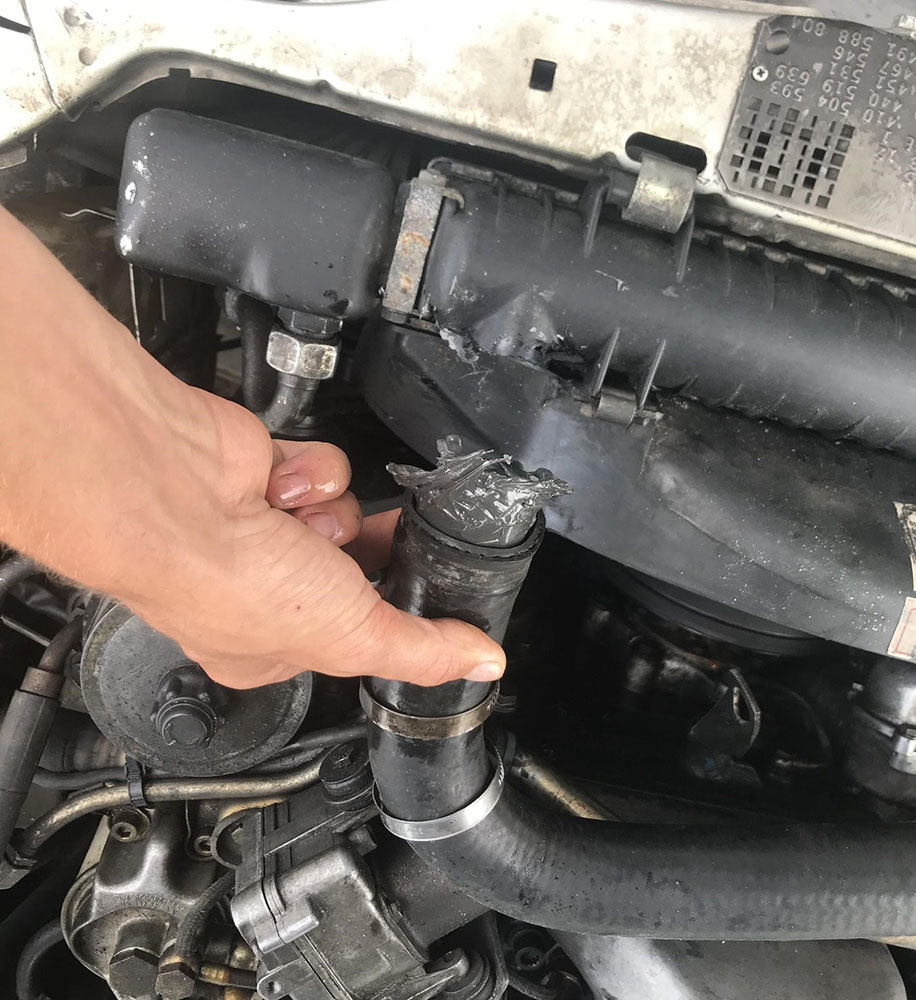
This worked alright until I got it up to temperature and then it began to leak again. I let it cool down and decided to bite the bullet and get a new radiator. I ordered one and eagerly awaited for it to arrive. When it did, I quickly swapped the new radiator in and proceeded with another round of testing. This time, my W123 300D Mercedes was running great, no grinding, no squeaking, no unusual noises at all, and no leaks.
My W123 On the Road Again
It was time for the maiden voyage. I nervously put her into drive and slowly started to creep. I got on an old back road so that if anything happened I wouldn't be in traffic. Time to get up to speed; I went to half throttle and began to accelerate. I went through first gear, it shifted to second, it shifted to third, and then finally settled in fourth gear. No crazy noises; I cruised for about half an hour and went home. There were no leaks and she still sounded great.
It took me three months and nearly all of my quarantine time
to get her back on the road. Other than the mismatched
panels you can barely tell anything happened. Overall I gained valuable
knowledge about my car and can move to restore her even more in the future.

Finishing Up
When all of the work was done I realized I now had an
abundance of spare parts from the donor car. The blue interior wouldn't go well
with my tan one so I decided to take it apart and sell the whole interior and extra
parts as one lot. I didn't have any storage so it had to go quickly. I sold it
relatively cheap but it was enough to cover the cost of the parts car, fluids,
and the shop fees. At the end of the day, I broke even, but that was good
enough for me. I had the empty chassis hauled off and started to enjoy my new
two-tone Mercedes.
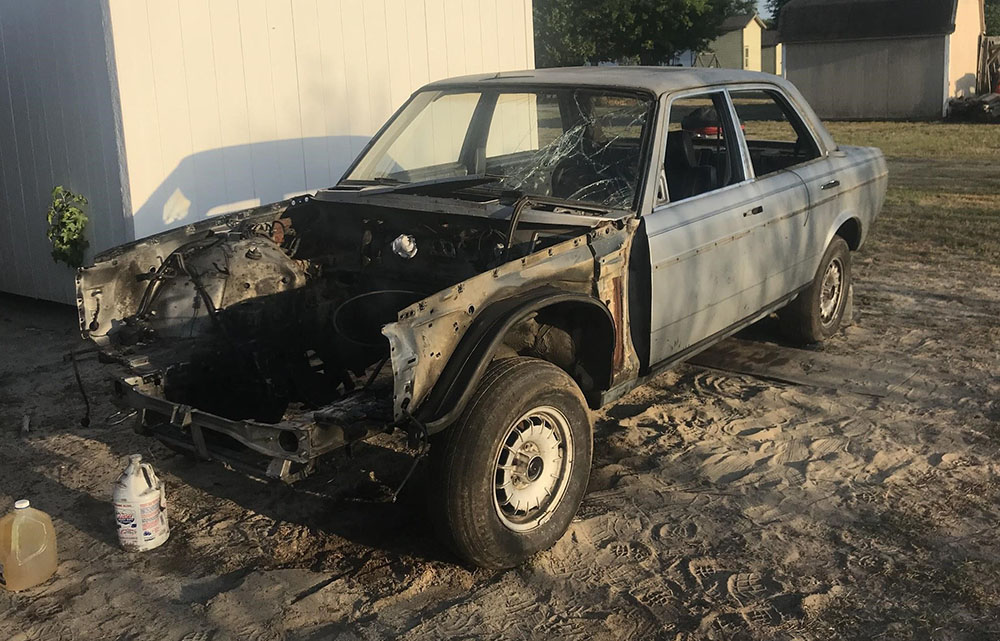
I would like to take a moment to thank all of the wonderful
people who shared their knowledge and time with me on this build. If it wasn't
for their wise instruction, my beloved W123 Mercedes 300D may not have survived 2020.
Shop Mercedes W123 Parts Here


